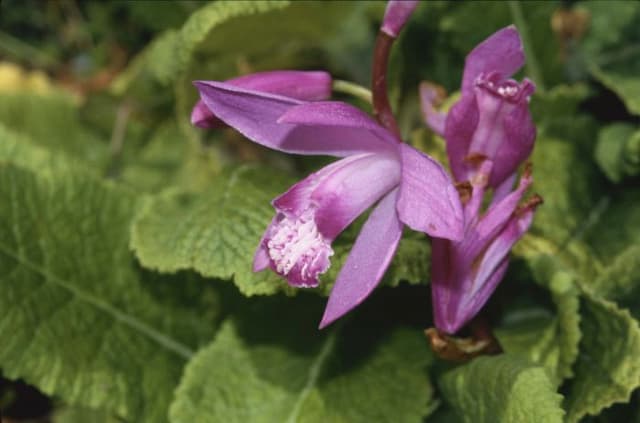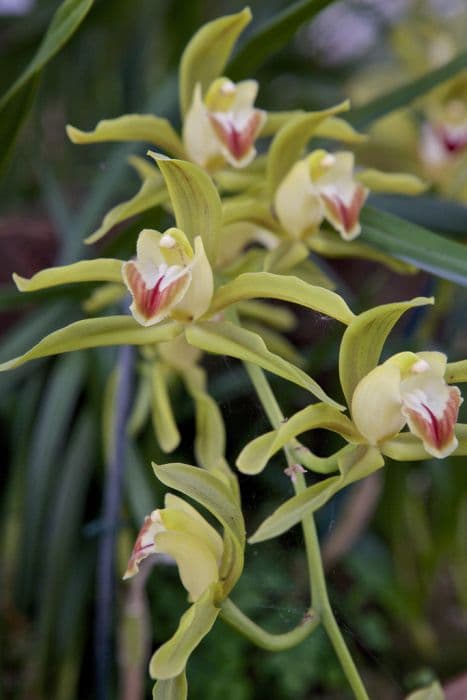Hyacinth Orchid Arpophyllum spicatum

ABOUT
Commonly known as the hyacinth orchid, Arpophyllum spicatum is a captivating plant most notable for its striking flower arrangement. The plant's foliage consists of long, strap-like leaves that are glossy and deep green, forming dense clusters from which the prominent floral spikes emerge. Each spike carries numerous small, closely spaced flowers which contribute to the overall appearance reminiscent of a hyacinth. The blooms exhibit a vibrant magenta or pink hue, and they are distinguished by their tubular structure which flares at the tip to reveal six delicate lobes. These flowers usually form a cylindrical, brush-like cluster atop the tall, erect spike, creating a showy and unusual visual display. The overall impression is of a lush foliage base from which the eye-catching, colorful floral spires extend, lending the plant its common name due to the similarity to the hyacinth flowers in shape and form.
About this plant
 Names
NamesFamily
Orchidaceae
Synonyms
Hyacinth Orchid, Candle Orchid
Common names
Apopellia spicata, Hexisea spicata, Stenia pallida.
 Toxicity
ToxicityTo humans
Arpophyllum spicatum, commonly known as the Hyacinth Orchid, is not typically recognized as a poisonous plant to humans. It doesn't contain any well-known toxic compounds, and cases of poisoning from ingestion are rare or undocumented. However, it is generally advised that no part of ornamental plants be ingested, and any plant material can potentially cause gastrointestinal discomfort if consumed. If any part of the Hyacinth Orchid is ingested and an adverse reaction is observed, medical attention should be sought.
To pets
The Hyacinth Orchid (Arpophyllum spicatum) is generally not known to be toxic to pets. There is limited information on its toxicity, but it is not listed as a common toxic plant to animals such as cats and dogs. However, individual animals might have sensitivities, and the ingestion of plant parts can cause mild stomach upset in some pets. If a pet consumes part of a Hyacinth Orchid and shows signs of distress or illness, consulting a veterinarian is recommended.
 Characteristics
CharacteristicsLife cycle
Perennials
Foliage type
Evergreen
Color of leaves
Green
Flower color
Pink
Height
3 feet 6 inches [1.07 meters]
Spread
3 feet [0.91 meters]
Plant type
Herb
Hardiness zones
10
Native area
Mexico
Benefits
 General Benefits
General Benefits- Ornamental value: Arpophyllum spicatum, commonly known as the Hyacinth Orchid, is appreciated for its striking spikes of pinkish-purple flowers that add beauty to gardens and landscapes.
- Habitat for wildlife: The flowers attract pollinators such as bees and butterflies, providing a source of nectar and contributing to ecosystem diversity.
- Cultural significance: In some cultures, the Hyacinth Orchid may have symbolic importance or be used in traditional ornamental horticulture.
- Education and research: As a member of the orchid family, Arpophyllum spicatum can be of interest to botanists and horticulturalists for study and understanding orchid growth and care.
- Hobby cultivation: For orchid enthusiasts, cultivating Hyacinth Orchids offers a rewarding experience due to their unique appearance and the challenge they present to growers.
 Medical Properties
Medical PropertiesThis plant is not used for medical purposes.
 Air-purifying Qualities
Air-purifying QualitiesThis plant is not specifically known for air purifying qualities.
 Other Uses
Other Uses- The cane-like stems of Arpophyllum spicatum, commonly known as the Hyacinth Orchid, can be used to create small garden supports or stakes for supporting other plants in a garden.
- When in bloom, the Hyacinth Orchid can be used as a natural decoration in ceremonies or festive occasions due to its showy inflorescence.
- Its attractive flowers can be used in the horticultural industry for creating hybrid orchids with desirable traits like longer bloom time or unique colors.
- The Hyacinth Orchid's long-lasting flowers make it a suitable candidate for cut flower arrangements, adding a tropical touch to bouquets.
- The plant can be grown as a living privacy screen on balconies or in small gardens, where its dense foliage provides seclusion.
- Eco-friendly artists might use its dried seed pods for ornamental purposes in crafting projects, jewelry making, or as part of mixed media artworks.
- In areas where the plant is native, it can contribute to local biodiversity by providing habitat and food for specific pollinators like bees and hummingbirds.
- The intricate structure of its flowers can be studied by botany students or used in educational settings to illustrate orchid pollination mechanisms.
- Because of their appealing appearance, Hyacinth Orchids can be often used as a natural means to enhance the aesthetics of urban spaces when planted strategically.
- Photographers might find the Hyacinth Orchid particularly attractive as a subject for botanical photography, using it to practice macro photography skills.
Interesting Facts
 Feng Shui
Feng ShuiThe Hyacinth Orchid is not used in Feng Shui practice.
 Zodiac Sign Compitability
Zodiac Sign CompitabilityThe Hyacinth Orchid is not used in astrology practice.
 Plant Symbolism
Plant SymbolismThere is no widely recognized symbolic meaning for Arpophyllum spicatum, commonly known as the Hyacinth Orchid. Plant symbolism often varies by culture and individual interpretation, but as a lesser-known species, this particular orchid does not have a broadly acknowledged set of symbolic meanings. Generally, orchids can symbolize love, beauty, fertility, and refinement among other things, which could be extrapolated to the Hyacinth Orchid. However, without specific historical or cultural associations, it would be speculative to attribute these meanings to Arpophyllum spicatum directly.
 Water
WaterThe Hyacinth Orchid needs to be watered once every week, with a little more frequency during the active growing season in spring and summer. The soil should be allowed to dry out slightly between waterings. Typically, use about 16 ounces of water for smaller pots and up to 1 gallon for larger containers, depending on the size of the plant and the pot. Be careful not to let the plant sit in water as it can lead to root rot. Reduce watering in the fall and winter when the plant is not actively growing.
 Light
LightThe Hyacinth Orchid thrives in bright, indirect light. It's best placed in an east-facing window where it can enjoy the morning light or a few feet away from a south or west-facing window to avoid the harsh midday sun. Direct sunlight can scorch the leaves, so ensure the light is filtered or diffused.
 Temperature
TemperatureThe Hyacinth Orchid prefers moderate temperatures, ideally between 60 and 80 degrees Fahrenheit. It can tolerate a minimum temperature of about 50 degrees Fahrenheit, but shouldn't be exposed to temperatures below that. The plant can handle up to about 90 degrees Fahrenheit, but it's crucial to avoid sudden temperature changes.
 Pruning
PruningPrune the Hyacinth Orchid to remove any dead or damaged blooms and foliage, usually after the flowering period. This helps to encourage more blooms and maintains a tidy appearance. Pruning can be done every year or as needed to remove spent flower spikes and leaves.
 Cleaning
CleaningAs needed
 Soil
SoilThe Hyacinth Orchid thrives best in a well-draining orchid mix with fir bark, charcoal, and perlite components that mimic its natural epiphytic environment. The ideal soil pH for the Hyacinth Orchid should be slightly acidic to neutral, ranging from 5.5 to 7.0 to ensure optimal growth.
 Repotting
RepottingHyacinth Orchids should be repotted every 2 to 3 years or when the potting mix starts to degrade. Repotting is best done after flowering when new growth begins to ensure minimal disruption to the plant's cycle.
 Humidity & Misting
Humidity & MistingHyacinth Orchids prefer high humidity levels, ideally between 50% and 70%, to thrive. Providing constant, adequate humidity is key for healthy growth, particularly for indoor cultivation.
 Suitable locations
Suitable locationsIndoor
Place in bright, indirect light with high humidity and airflow.
Outdoor
Grow in dappled sunlight, protect from extreme temperatures.
Hardiness zone
10-11 USDA
 Life cycle
Life cycleArpophyllum spicatum, commonly known as the Hyacinth Orchid, begins its life cycle as a seed, relying on a symbiotic relationship with a mycorrhizal fungus to germinate and establish itself. This orchid typically develops a pseudobulb from which leaves emerge, providing energy through photosynthesis for growth and development. Following vegetative growth, the Hyacinth Orchid enters the reproductive phase, producing a flower spike adorned with numerous pink to purplish flowers that attract pollinators for sexual reproduction. After successful pollination, fruits in the form of capsules develop, containing numerous tiny seeds which are then dispersed, often by wind due to their lightweight and small size. The seeds require the right environmental conditions as well as the presence of specific mycorrhizal fungi to germinate and start a new cycle. Throughout its life, this orchid may experience multiple flowering cycles, typically thriving in humid and forested environments.
 Propogation
PropogationPropogation time
Spring to summer
Propogation: The most popular method of propagating the Hyacinth Orchid (Arpophyllum spicatum) is through division. Typically, the best time to do this is in the spring or early summer when the plant has finished blooming and is beginning a new growth cycle. To propagate by division, carefully remove the plant from its container and gently separate the pseudobulbs, ensuring that each division has at least one growth point or "eye." Use a sharp, sterile knife to make any necessary cuts. The divisions can then be potted in fresh orchid potting mix, ideally in smaller pots that snugly accommodate the divided pseudobulbs. Water them sparingly until new growth indicates that the plant has established a good root system. This method leverages the plant's natural clumping growth habit to create new, independent plants.








